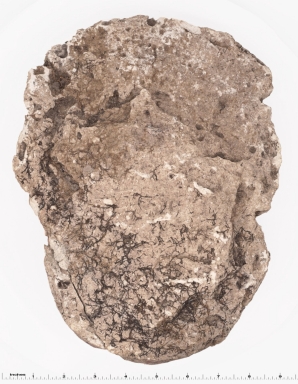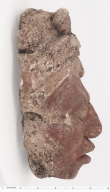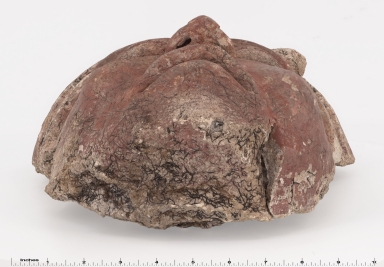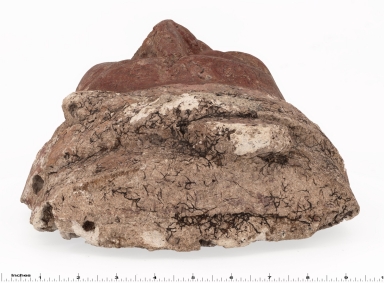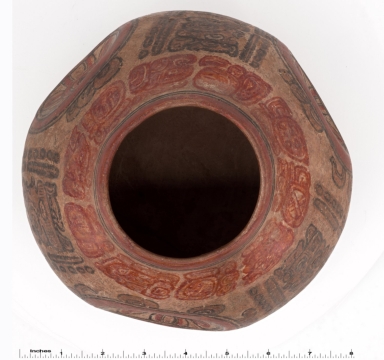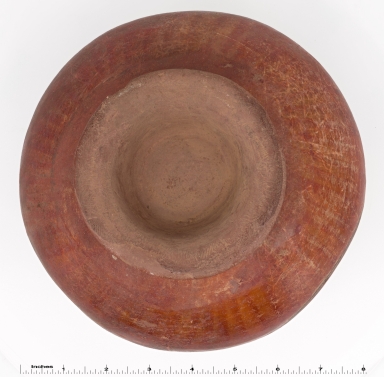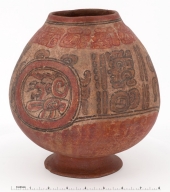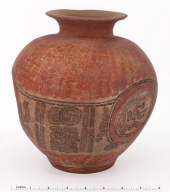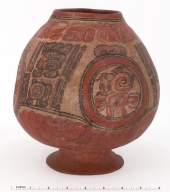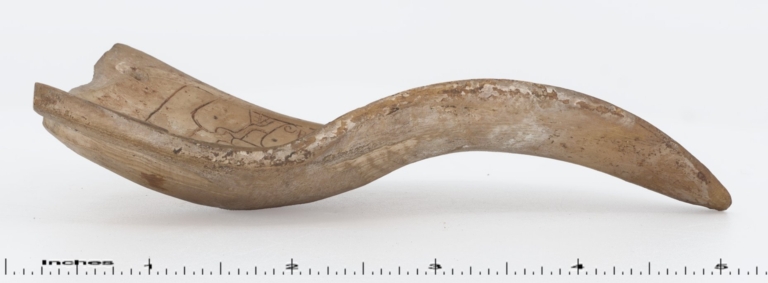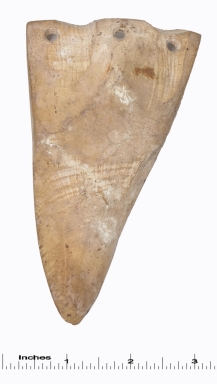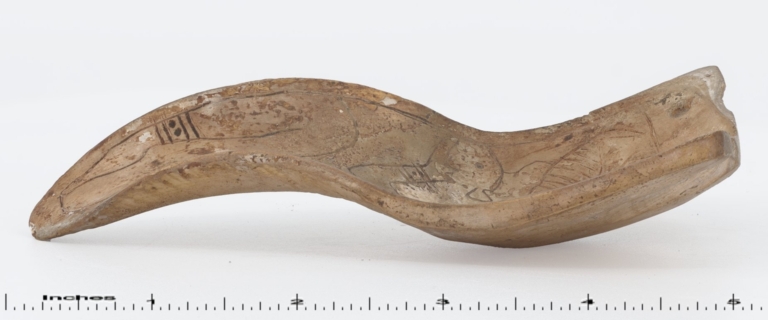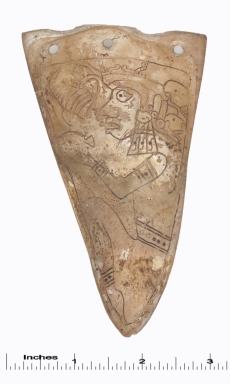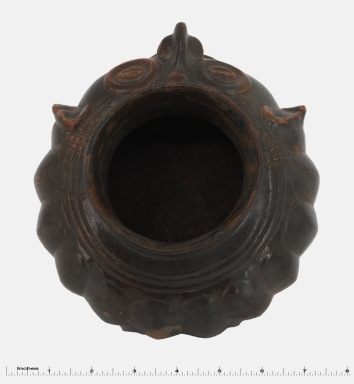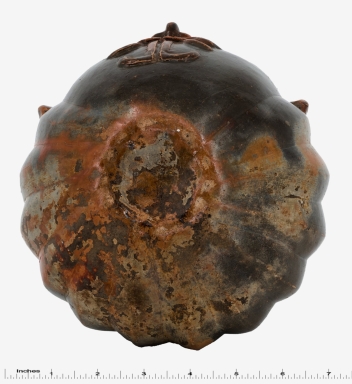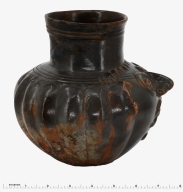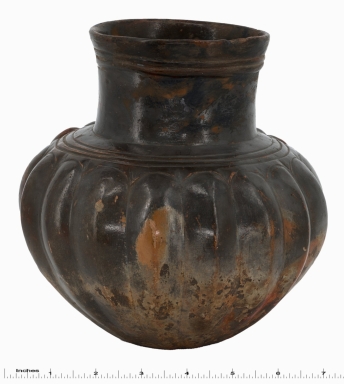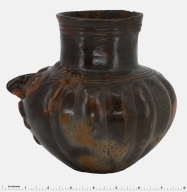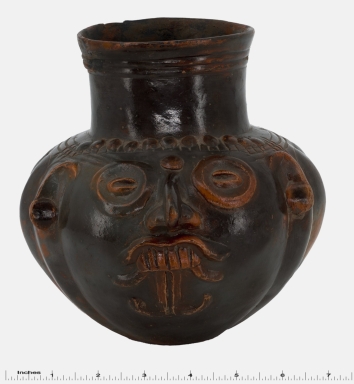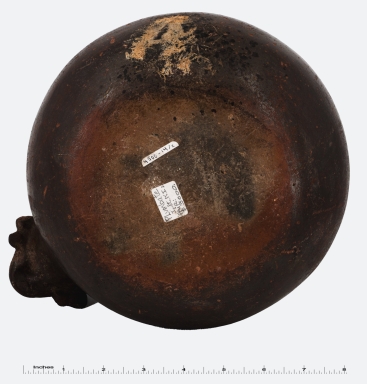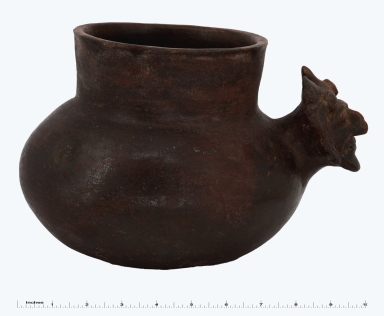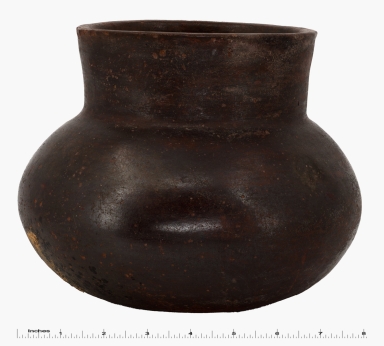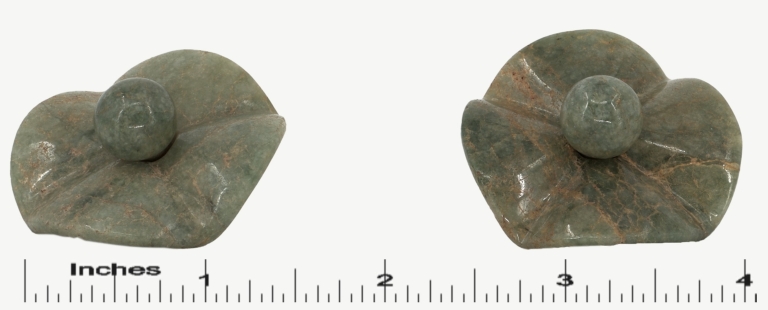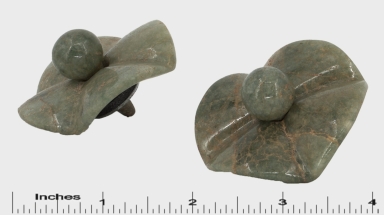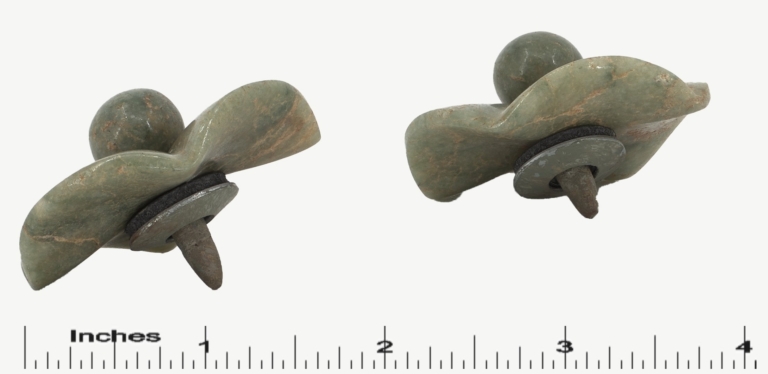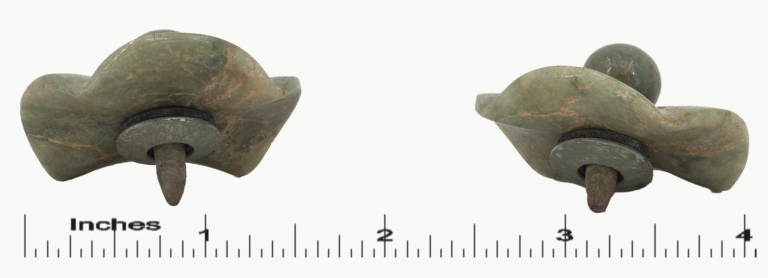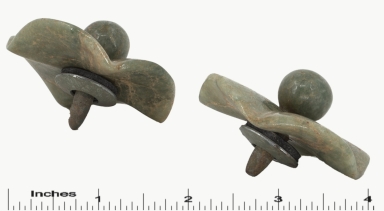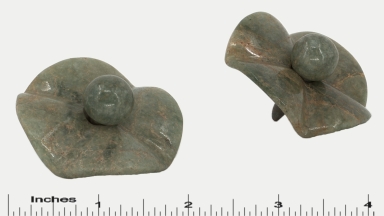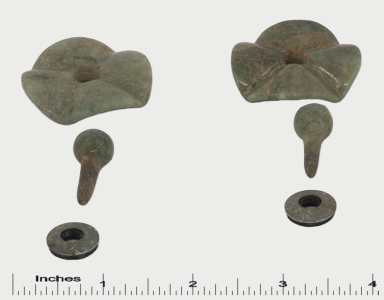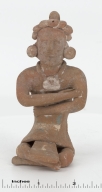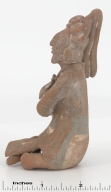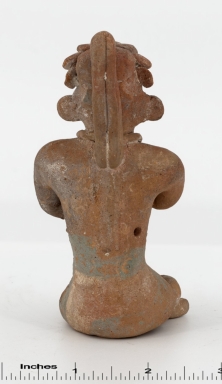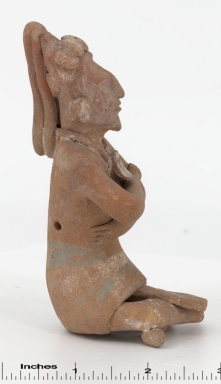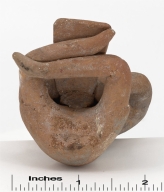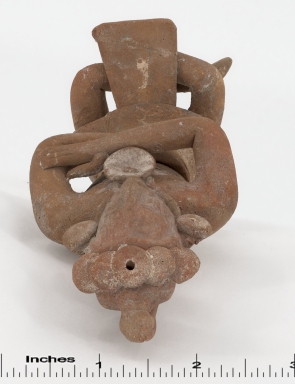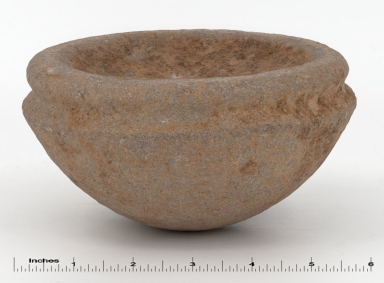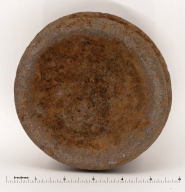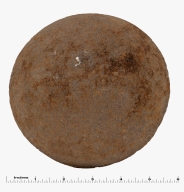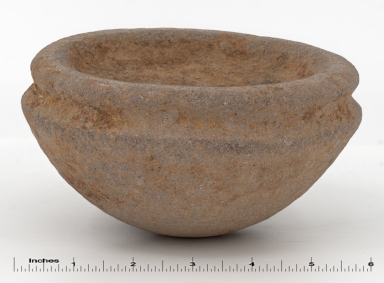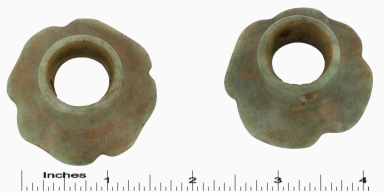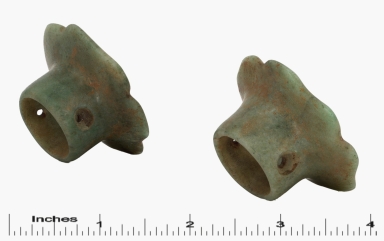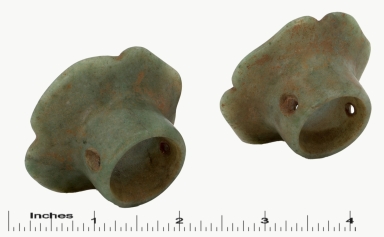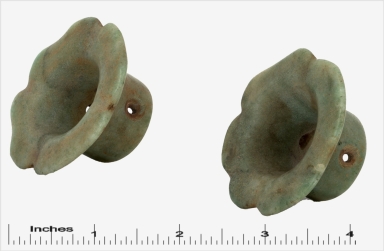|
Title
Elite male wearing a headdress : portrait.
Description
Elite males wore elaborate headdresses. They painted their bodies red and black to indicate they were warriors. Teeth were filed and the incisors were notched for dental inlays of jade and pyrite. This portrait is an architectural element or part of a building.
Subject
[Stucco sculpture--Mexico, Maya sculpture--Mexico, Maya art--Mexico, Mayas--Antiquities, Indigenous peoples--Antiquities]
Date
between 500 and 800
Title
Elite male wearing a headdress : portrait.
Description
Elite males wore elaborate headdresses. They painted their bodies red and black to indicate they were warriors. Teeth were filed and the incisors were notched for dental inlays of jade and pyrite. This portrait is an architectural element or part of a building.
Subject
[Stucco sculpture--Mexico, Maya sculpture--Mexico, Maya art--Mexico, Mayas--Antiquities, Indigenous peoples--Antiquities]
Date
between 500 and 800
Title
Elite male wearing a headdress : portrait.
Description
Elite males wore elaborate headdresses. They painted their bodies red and black to indicate they were warriors. Teeth were filed and the incisors were notched for dental inlays of jade and pyrite. This portrait is an architectural element or part of a building.
Subject
[Stucco sculpture--Mexico, Maya sculpture--Mexico, Maya art--Mexico, Mayas--Antiquities, Indigenous peoples--Antiquities]
Date
between 500 and 800
Title
Elite male wearing a headdress : portrait.
Description
Elite males wore elaborate headdresses. They painted their bodies red and black to indicate they were warriors. Teeth were filed and the incisors were notched for dental inlays of jade and pyrite. This portrait is an architectural element or part of a building.
Subject
[Stucco sculpture--Mexico, Maya sculpture--Mexico, Maya art--Mexico, Mayas--Antiquities, Indigenous peoples--Antiquities]
Date
between 500 and 800
Title
Elite male wearing a headdress : portrait.
Description
Elite males wore elaborate headdresses. They painted their bodies red and black to indicate they were warriors. Teeth were filed and the incisors were notched for dental inlays of jade and pyrite. This portrait is an architectural element or part of a building.
Subject
[Stucco sculpture--Mexico, Maya sculpture--Mexico, Maya art--Mexico, Mayas--Antiquities, Indigenous peoples--Antiquities]
Date
between 500 and 800
Title
Maya pedestal polychrome vessel.
Description
The form and the surface decorations of this vessel are very elaborate. The artisan created a teardrop-shaped vessel with a pedestal foot and three equally spaced sunken roundels in the body. He painted the vessel with a cream slip upon which he drew a band of glyphs around the mouth and a stylized profile heads in each roundel with alternating vertical glyphs in a column.
Subject
[Drinking vessels--El Salvador, Pottery--El Salvador, Maya art--El Salvador, Mayas--Antiquities, Indigenous peoples--Antiquities]
Date
between 500 and 800
Title
Maya pedestal polychrome vessel.
Description
The form and the surface decorations of this vessel are very elaborate. The artisan created a teardrop-shaped vessel with a pedestal foot and three equally spaced sunken roundels in the body. He painted the vessel with a cream slip upon which he drew a band of glyphs around the mouth and a stylized profile heads in each roundel with alternating vertical glyphs in a column.
Subject
[Drinking vessels--El Salvador, Pottery--El Salvador, Maya art--El Salvador, Mayas--Antiquities, Indigenous peoples--Antiquities]
Date
between 500 and 800
Title
Maya pedestal polychrome vessel.
Description
The form and the surface decorations of this vessel are very elaborate. The artisan created a teardrop-shaped vessel with a pedestal foot and three equally spaced sunken roundels in the body. He painted the vessel with a cream slip upon which he drew a band of glyphs around the mouth and a stylized profile heads in each roundel with alternating vertical glyphs in a column.
Subject
[Drinking vessels--El Salvador, Pottery--El Salvador, Maya art--El Salvador, Mayas--Antiquities, Indigenous peoples--Antiquities]
Date
between 500 and 800
Title
Maya pedestal polychrome vessel.
Description
The form and the surface decorations of this vessel are very elaborate. The artisan created a teardrop-shaped vessel with a pedestal foot and three equally spaced sunken roundels in the body. He painted the vessel with a cream slip upon which he drew a band of glyphs around the mouth and a stylized profile heads in each roundel with alternating vertical glyphs in a column.
Subject
[Drinking vessels--El Salvador, Pottery--El Salvador, Maya art--El Salvador, Mayas--Antiquities, Indigenous peoples--Antiquities]
Date
between 500 and 800
Title
Maya pedestal polychrome vessel.
Description
The form and the surface decorations of this vessel are very elaborate. The artisan created a teardrop-shaped vessel with a pedestal foot and three equally spaced sunken roundels in the body. He painted the vessel with a cream slip upon which he drew a band of glyphs around the mouth and a stylized profile heads in each roundel with alternating vertical glyphs in a column.
Subject
[Drinking vessels--El Salvador, Pottery--El Salvador, Maya art--El Salvador, Mayas--Antiquities, Indigenous peoples--Antiquities]
Date
between 500 and 800
Title
Maya pedestal polychrome vessel.
Description
The form and the surface decorations of this vessel are very elaborate. The artisan created a teardrop-shaped vessel with a pedestal foot and three equally spaced sunken roundels in the body. He painted the vessel with a cream slip upon which he drew a band of glyphs around the mouth and a stylized profile heads in each roundel with alternating vertical glyphs in a column.
Subject
[Drinking vessels--El Salvador, Pottery--El Salvador, Maya art--El Salvador, Mayas--Antiquities, Indigenous peoples--Antiquities]
Date
between 500 and 800
Title
Maya shell pectoral.
Description
A triangular section from the interior of a lightning whelk shell has been incised with a kneeling male figure. He holds a knife in his left hand and a large shell in his right. Maya shell pectoral / pendant.
Subject
[Pendants (Jewelry)--Mexico (Yucatan), Maya art--Mexico (Yucatan), Mayas--Antiquities, Indigenous peoples--Antiquities]
Date
between 520 and 800
Title
Maya shell pectoral.
Description
A triangular section from the interior of a lightning whelk shell has been incised with a kneeling male figure. He holds a knife in his left hand and a large shell in his right. Maya shell pectoral / pendant.
Subject
[Pendants (Jewelry)--Mexico (Yucatan), Maya art--Mexico (Yucatan), Mayas--Antiquities, Indigenous peoples--Antiquities]
Date
between 520 and 800
Title
Maya shell pectoral.
Description
A triangular section from the interior of a lightning whelk shell has been incised with a kneeling male figure. He holds a knife in his left hand and a large shell in his right. Maya shell pectoral / pendant.
Subject
[Pendants (Jewelry)--Mexico (Yucatan), Maya art--Mexico (Yucatan), Mayas--Antiquities, Indigenous peoples--Antiquities]
Date
between 520 and 800
Title
Maya shell pectoral.
Description
A triangular section from the interior of a lightning whelk shell has been incised with a kneeling male figure. He holds a knife in his left hand and a large shell in his right. Maya shell pectoral / pendant.
Subject
[Pendants (Jewelry)--Mexico (Yucatan), Maya art--Mexico (Yucatan), Mayas--Antiquities, Indigenous peoples--Antiquities]
Date
between 520 and 800
Title
Maya plumbate choc vessel.
Description
The elite of Mesoamerica were always looking for new and better elite vessels to serve their guests cacao. A new type of ceramic, plumbate ware, appealed to their sensabilities for its varigated, shiny, metallic surface. This phytomorhpic cacao vessel depicts the maya rain god Chac.
Subject
[Drinking vessels--Guatemala, Pottery--Guatemala, Ceramic sculpture--Guatemala, Mayas--Antiquities, Indigenous peoples--Antiquities]
Date
between 900 and 1250
Title
Maya plumbate choc vessel.
Description
The elite of Mesoamerica were always looking for new and better elite vessels to serve their guests cacao. A new type of ceramic, plumbate ware, appealed to their sensabilities for its varigated, shiny, metallic surface. This phytomorhpic cacao vessel depicts the maya rain god Chac.
Subject
[Drinking vessels--Guatemala, Pottery--Guatemala, Ceramic sculpture--Guatemala, Mayas--Antiquities, Indigenous peoples--Antiquities]
Date
between 900 and 1250
Title
Maya plumbate choc vessel.
Description
The elite of Mesoamerica were always looking for new and better elite vessels to serve their guests cacao. A new type of ceramic, plumbate ware, appealed to their sensabilities for its varigated, shiny, metallic surface. This phytomorhpic cacao vessel depicts the maya rain god Chac.
Subject
[Drinking vessels--Guatemala, Pottery--Guatemala, Ceramic sculpture--Guatemala, Mayas--Antiquities, Indigenous peoples--Antiquities]
Date
between 900 and 1250
Title
Maya plumbate choc vessel.
Description
The elite of Mesoamerica were always looking for new and better elite vessels to serve their guests cacao. A new type of ceramic, plumbate ware, appealed to their sensabilities for its varigated, shiny, metallic surface. This phytomorhpic cacao vessel depicts the maya rain god Chac.
Subject
[Drinking vessels--Guatemala, Pottery--Guatemala, Ceramic sculpture--Guatemala, Mayas--Antiquities, Indigenous peoples--Antiquities]
Date
between 900 and 1250
Title
Maya plumbate choc vessel.
Description
The elite of Mesoamerica were always looking for new and better elite vessels to serve their guests cacao. A new type of ceramic, plumbate ware, appealed to their sensabilities for its varigated, shiny, metallic surface. This phytomorhpic cacao vessel depicts the maya rain god Chac.
Subject
[Drinking vessels--Guatemala, Pottery--Guatemala, Ceramic sculpture--Guatemala, Mayas--Antiquities, Indigenous peoples--Antiquities]
Date
between 900 and 1250
Title
Maya plumbate choc vessel.
Description
The elite of Mesoamerica were always looking for new and better elite vessels to serve their guests cacao. A new type of ceramic, plumbate ware, appealed to their sensabilities for its varigated, shiny, metallic surface. This phytomorhpic cacao vessel depicts the maya rain god Chac.
Subject
[Drinking vessels--Guatemala, Pottery--Guatemala, Ceramic sculpture--Guatemala, Mayas--Antiquities, Indigenous peoples--Antiquities]
Date
between 900 and 1250
Title
A pair of Maya plumbate vessels : deity Head : B.
Description
Two similar plumbate ollas were formed from a bulb bottom, a flaring high neck collar rim, and fanged deity applique. The fang deities represent concepts of one or uniqueness and duality or opposition.
Subject
[Drinking vessels--Guatemala, Pottery--Guatemala, Ceramic tableware--Guatemala, Maya art--Guatemala, Mayas--Antiquities, Indigenous peoples--Antiquities]
Date
between 500 and 800
Title
A pair of Maya plumbate vessels : deity Head : B.
Description
Two similar plumbate ollas were formed from a bulb bottom, a flaring high neck collar rim, and fanged deity applique. The fang deities represent concepts of one or uniqueness and duality or opposition.
Subject
[Drinking vessels--Guatemala, Pottery--Guatemala, Ceramic tableware--Guatemala, Maya art--Guatemala, Mayas--Antiquities, Indigenous peoples--Antiquities]
Date
between 500 and 800
Title
A pair of Maya plumbate vessels : deity Head : B.
Description
Two similar plumbate ollas were formed from a bulb bottom, a flaring high neck collar rim, and fanged deity applique. The fang deities represent concepts of one or uniqueness and duality or opposition.
Subject
[Drinking vessels--Guatemala, Pottery--Guatemala, Ceramic tableware--Guatemala, Maya art--Guatemala, Mayas--Antiquities, Indigenous peoples--Antiquities]
Date
between 500 and 800
Title
A pair of Maya plumbate vessels : deity Head : B.
Description
Two similar plumbate ollas were formed from a bulb bottom, a flaring high neck collar rim, and fanged deity applique. The fang deities represent concepts of one or uniqueness and duality or opposition.
Subject
[Drinking vessels--Guatemala, Pottery--Guatemala, Ceramic tableware--Guatemala, Maya art--Guatemala, Mayas--Antiquities, Indigenous peoples--Antiquities]
Date
between 500 and 800
Title
A pair of Maya plumbate vessels : deity Head : B.
Description
Two similar plumbate ollas were formed from a bulb bottom, a flaring high neck collar rim, and fanged deity applique. The fang deities represent concepts of one or uniqueness and duality or opposition.
Subject
[Drinking vessels--Guatemala, Pottery--Guatemala, Ceramic tableware--Guatemala, Maya art--Guatemala, Mayas--Antiquities, Indigenous peoples--Antiquities]
Date
between 500 and 800
Title
A pair of Maya plumbate vessels : deity Head : B.
Description
Two similar plumbate ollas were formed from a bulb bottom, a flaring high neck collar rim, and fanged deity applique. The fang deities represent concepts of one or uniqueness and duality or opposition.
Subject
[Drinking vessels--Guatemala, Pottery--Guatemala, Ceramic tableware--Guatemala, Maya art--Guatemala, Mayas--Antiquities, Indigenous peoples--Antiquities]
Date
between 500 and 800
Title
Pair of Maya jade ear flares.
Description
These blue-green jade ear flared have been string cut, chipped, abraded, drilled, and polished to form a flower. The petals represent the four cardinal directions, while the ball an post stands for the verticality of up and down. The design represents the Maya "Quincunx" or the five directions of their world or universe.
Subject
[Jewelry--Central America, Stone carving--Central America, Decoration and ornament--Central America, Maya art--Central America, Mayas--Antiquities, Indigenous peoples--Antiquities, Mayas--Jewelry]
Date
between 500 and 900
Title
Pair of Maya jade ear flares.
Description
These blue-green jade ear flared have been string cut, chipped, abraded, drilled, and polished to form a flower. The petals represent the four cardinal directions, while the ball an post stands for the verticality of up and down. The design represents the Maya "Quincunx" or the five directions of their world or universe.
Subject
[Jewelry--Central America, Stone carving--Central America, Decoration and ornament--Central America, Maya art--Central America, Mayas--Antiquities, Indigenous peoples--Antiquities, Mayas--Jewelry]
Date
between 500 and 900
Title
Pair of Maya jade ear flares.
Description
These blue-green jade ear flared have been string cut, chipped, abraded, drilled, and polished to form a flower. The petals represent the four cardinal directions, while the ball an post stands for the verticality of up and down. The design represents the Maya "Quincunx" or the five directions of their world or universe.
Subject
[Jewelry--Central America, Stone carving--Central America, Decoration and ornament--Central America, Maya art--Central America, Mayas--Antiquities, Indigenous peoples--Antiquities, Mayas--Jewelry]
Date
between 500 and 900
Title
Pair of Maya jade ear flares.
Description
These blue-green jade ear flared have been string cut, chipped, abraded, drilled, and polished to form a flower. The petals represent the four cardinal directions, while the ball an post stands for the verticality of up and down. The design represents the Maya "Quincunx" or the five directions of their world or universe.
Subject
[Jewelry--Central America, Stone carving--Central America, Decoration and ornament--Central America, Maya art--Central America, Mayas--Antiquities, Indigenous peoples--Antiquities, Mayas--Jewelry]
Date
between 500 and 900
Title
Pair of Maya jade ear flares.
Description
These blue-green jade ear flared have been string cut, chipped, abraded, drilled, and polished to form a flower. The petals represent the four cardinal directions, while the ball an post stands for the verticality of up and down. The design represents the Maya "Quincunx" or the five directions of their world or universe.
Subject
[Jewelry--Central America, Stone carving--Central America, Decoration and ornament--Central America, Maya art--Central America, Mayas--Antiquities, Indigenous peoples--Antiquities, Mayas--Jewelry]
Date
between 500 and 900
Title
Pair of Maya jade ear flares.
Description
These blue-green jade ear flared have been string cut, chipped, abraded, drilled, and polished to form a flower. The petals represent the four cardinal directions, while the ball an post stands for the verticality of up and down. The design represents the Maya "Quincunx" or the five directions of their world or universe.
Subject
[Jewelry--Central America, Stone carving--Central America, Decoration and ornament--Central America, Maya art--Central America, Mayas--Antiquities, Indigenous peoples--Antiquities, Mayas--Jewelry]
Date
between 500 and 900
Title
Pair of Maya jade ear flares.
Description
These blue-green jade ear flared have been string cut, chipped, abraded, drilled, and polished to form a flower. The petals represent the four cardinal directions, while the ball an post stands for the verticality of up and down. The design represents the Maya "Quincunx" or the five directions of their world or universe.
Subject
[Jewelry--Central America, Stone carving--Central America, Decoration and ornament--Central America, Maya art--Central America, Mayas--Antiquities, Indigenous peoples--Antiquities, Mayas--Jewelry]
Date
between 500 and 900
Title
Jaina figure : whistle.
Description
The elite Maya surrounded themselves with luxury goods. This chief wears an elaborate hairdo, headband, ear spools, and shell necklace. His face shows signs of tattooing and his head has been reshaped when he was just born. The modified head with sloping forehead represents the end of elote, maize, or corn and the long flowing hair the corn silk.
Subject
[Whistles--Mexico--Jaina Island, Ceramic sculpture--Mexico--Jaina Island, Maya sculpture--Mexico--Jaina Island, Mayas--Antiquities, Maya art--Mexico--Jaina Island, Indigenous peoples--Antiquities]
Date
between 300 and 900
Title
Jaina figure : whistle.
Description
The elite Maya surrounded themselves with luxury goods. This chief wears an elaborate hairdo, headband, ear spools, and shell necklace. His face shows signs of tattooing and his head has been reshaped when he was just born. The modified head with sloping forehead represents the end of elote, maize, or corn and the long flowing hair the corn silk.
Subject
[Whistles--Mexico--Jaina Island, Ceramic sculpture--Mexico--Jaina Island, Maya sculpture--Mexico--Jaina Island, Mayas--Antiquities, Maya art--Mexico--Jaina Island, Indigenous peoples--Antiquities]
Date
between 300 and 900
Title
Jaina figure : whistle.
Description
The elite Maya surrounded themselves with luxury goods. This chief wears an elaborate hairdo, headband, ear spools, and shell necklace. His face shows signs of tattooing and his head has been reshaped when he was just born. The modified head with sloping forehead represents the end of elote, maize, or corn and the long flowing hair the corn silk.
Subject
[Whistles--Mexico--Jaina Island, Ceramic sculpture--Mexico--Jaina Island, Maya sculpture--Mexico--Jaina Island, Mayas--Antiquities, Maya art--Mexico--Jaina Island, Indigenous peoples--Antiquities]
Date
between 300 and 900
Title
Jaina figure : whistle.
Description
The elite Maya surrounded themselves with luxury goods. This chief wears an elaborate hairdo, headband, ear spools, and shell necklace. His face shows signs of tattooing and his head has been reshaped when he was just born. The modified head with sloping forehead represents the end of elote, maize, or corn and the long flowing hair the corn silk.
Subject
[Whistles--Mexico--Jaina Island, Ceramic sculpture--Mexico--Jaina Island, Maya sculpture--Mexico--Jaina Island, Mayas--Antiquities, Maya art--Mexico--Jaina Island, Indigenous peoples--Antiquities]
Date
between 300 and 900
Title
Jaina figure : whistle.
Description
The elite Maya surrounded themselves with luxury goods. This chief wears an elaborate hairdo, headband, ear spools, and shell necklace. His face shows signs of tattooing and his head has been reshaped when he was just born. The modified head with sloping forehead represents the end of elote, maize, or corn and the long flowing hair the corn silk.
Subject
[Whistles--Mexico--Jaina Island, Ceramic sculpture--Mexico--Jaina Island, Maya sculpture--Mexico--Jaina Island, Mayas--Antiquities, Maya art--Mexico--Jaina Island, Indigenous peoples--Antiquities]
Date
between 300 and 900
Title
Jaina figure : whistle.
Description
The elite Maya surrounded themselves with luxury goods. This chief wears an elaborate hairdo, headband, ear spools, and shell necklace. His face shows signs of tattooing and his head has been reshaped when he was just born. The modified head with sloping forehead represents the end of elote, maize, or corn and the long flowing hair the corn silk.
Subject
[Whistles--Mexico--Jaina Island, Ceramic sculpture--Mexico--Jaina Island, Maya sculpture--Mexico--Jaina Island, Mayas--Antiquities, Maya art--Mexico--Jaina Island, Indigenous peoples--Antiquities]
Date
between 300 and 900
Title
Mushroom cup : metate or molcajete.
Description
Small molcajetes are used to grind minerals, earth for colors or plants for medicine and drugs. The shape of this molcajete suggests the cap of a mushroom. Special mushrooms are used to enter hallucinogenic trances by a shaman to access different realities.
Subject
[Stone carving--Guatemala, Pottery--Guatemala, Maya sculpture--Guatemala, Mayas--Antiquities, Indigenous peoples--Antiquities]
Date
ca. 500 BC
Title
Mushroom cup : metate or molcajete.
Description
Small molcajetes are used to grind minerals, earth for colors or plants for medicine and drugs. The shape of this molcajete suggests the cap of a mushroom. Special mushrooms are used to enter hallucinogenic trances by a shaman to access different realities.
Subject
[Stone carving--Guatemala, Pottery--Guatemala, Maya sculpture--Guatemala, Mayas--Antiquities, Indigenous peoples--Antiquities]
Date
ca. 500 BC
Title
Mushroom cup : metate or molcajete.
Description
Small molcajetes are used to grind minerals, earth for colors or plants for medicine and drugs. The shape of this molcajete suggests the cap of a mushroom. Special mushrooms are used to enter hallucinogenic trances by a shaman to access different realities.
Subject
[Stone carving--Guatemala, Pottery--Guatemala, Maya sculpture--Guatemala, Mayas--Antiquities, Indigenous peoples--Antiquities]
Date
ca. 500 BC
Title
Mushroom cup : metate or molcajete.
Description
Small molcajetes are used to grind minerals, earth for colors or plants for medicine and drugs. The shape of this molcajete suggests the cap of a mushroom. Special mushrooms are used to enter hallucinogenic trances by a shaman to access different realities.
Subject
[Stone carving--Guatemala, Pottery--Guatemala, Maya sculpture--Guatemala, Mayas--Antiquities, Indigenous peoples--Antiquities]
Date
ca. 500 BC
Title
Mushroom cup : metate or molcajete.
Description
Small molcajetes are used to grind minerals, earth for colors or plants for medicine and drugs. The shape of this molcajete suggests the cap of a mushroom. Special mushrooms are used to enter hallucinogenic trances by a shaman to access different realities.
Subject
[Stone carving--Guatemala, Pottery--Guatemala, Maya sculpture--Guatemala, Mayas--Antiquities, Indigenous peoples--Antiquities]
Date
ca. 500 BC
Title
Mushroom cup : metate or molcajete.
Description
Small molcajetes are used to grind minerals, earth for colors or plants for medicine and drugs. The shape of this molcajete suggests the cap of a mushroom. Special mushrooms are used to enter hallucinogenic trances by a shaman to access different realities.
Subject
[Stone carving--Guatemala, Pottery--Guatemala, Maya sculpture--Guatemala, Mayas--Antiquities, Indigenous peoples--Antiquities]
Date
ca. 500 BC
Title
Pair of ear flares : quadripartite design.
Description
The Olmec and the Maya wore jade or jadeite beads, necklaces, and ear spools. The Maya elite placed a jade bead in the mouths of their dead as a sign of rebirth. The quadrapartite design represents the four cardinal directions and the hole the fifth direction or the Axis Mundi.
Subject
[Jewelry--Guatemala, Decoration and ornament--Guatemala, Stone carving--Guatemala, Maya art--Guatemala, Mayas--Antiquities, Indigenous peoples--Antiquities]
Date
between 500 and 900
Title
Pair of ear flares : quadripartite design.
Description
The Olmec and the Maya wore jade or jadeite beads, necklaces, and ear spools. The Maya elite placed a jade bead in the mouths of their dead as a sign of rebirth. The quadrapartite design represents the four cardinal directions and the hole the fifth direction or the Axis Mundi.
Subject
[Jewelry--Guatemala, Decoration and ornament--Guatemala, Stone carving--Guatemala, Maya art--Guatemala, Mayas--Antiquities, Indigenous peoples--Antiquities]
Date
between 500 and 900
Title
Pair of ear flares : quadripartite design.
Description
The Olmec and the Maya wore jade or jadeite beads, necklaces, and ear spools. The Maya elite placed a jade bead in the mouths of their dead as a sign of rebirth. The quadrapartite design represents the four cardinal directions and the hole the fifth direction or the Axis Mundi.
Subject
[Jewelry--Guatemala, Decoration and ornament--Guatemala, Stone carving--Guatemala, Maya art--Guatemala, Mayas--Antiquities, Indigenous peoples--Antiquities]
Date
between 500 and 900
Title
Pair of ear flares : quadripartite design.
Description
The Olmec and the Maya wore jade or jadeite beads, necklaces, and ear spools. The Maya elite placed a jade bead in the mouths of their dead as a sign of rebirth. The quadrapartite design represents the four cardinal directions and the hole the fifth direction or the Axis Mundi.
Subject
[Jewelry--Guatemala, Decoration and ornament--Guatemala, Stone carving--Guatemala, Maya art--Guatemala, Mayas--Antiquities, Indigenous peoples--Antiquities]
Date
between 500 and 900
|

